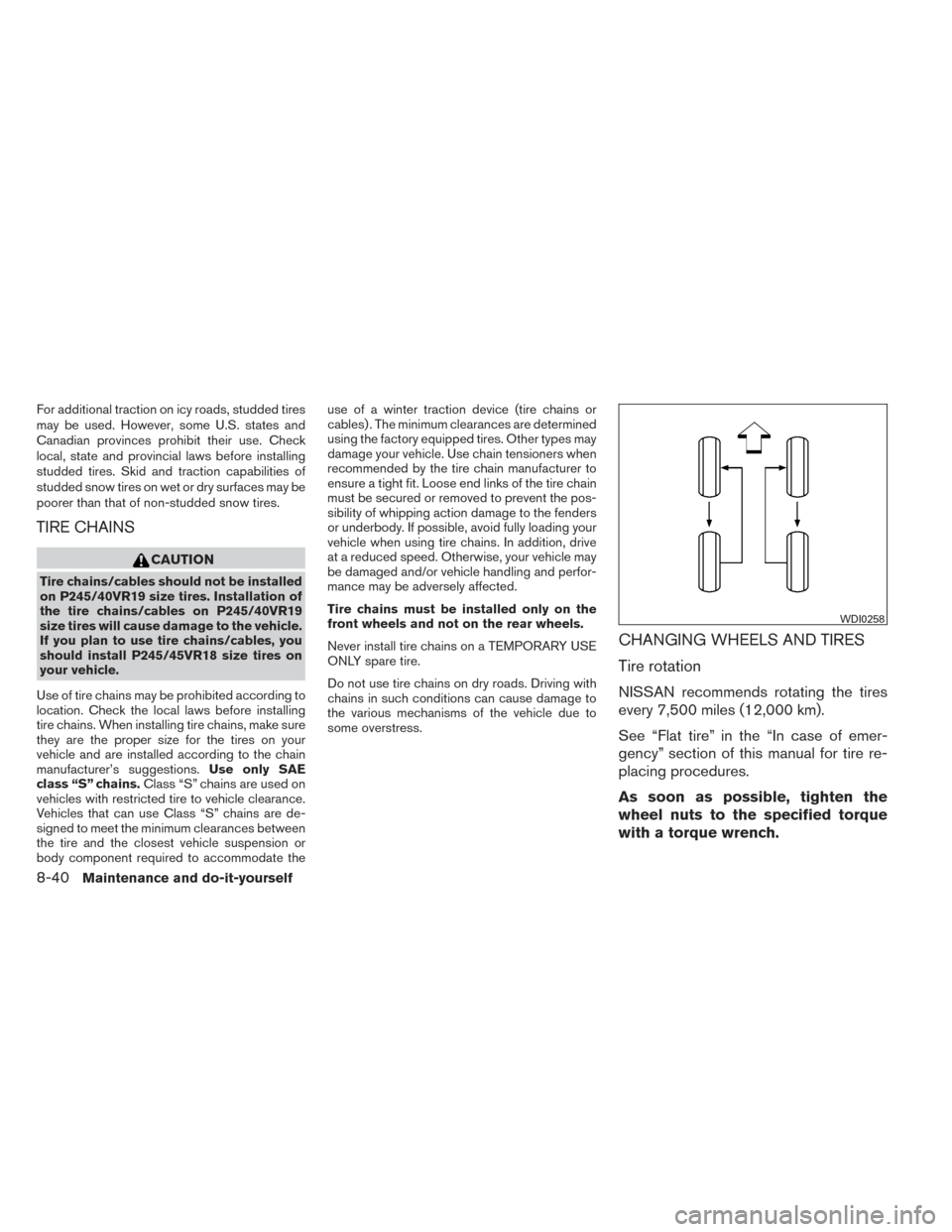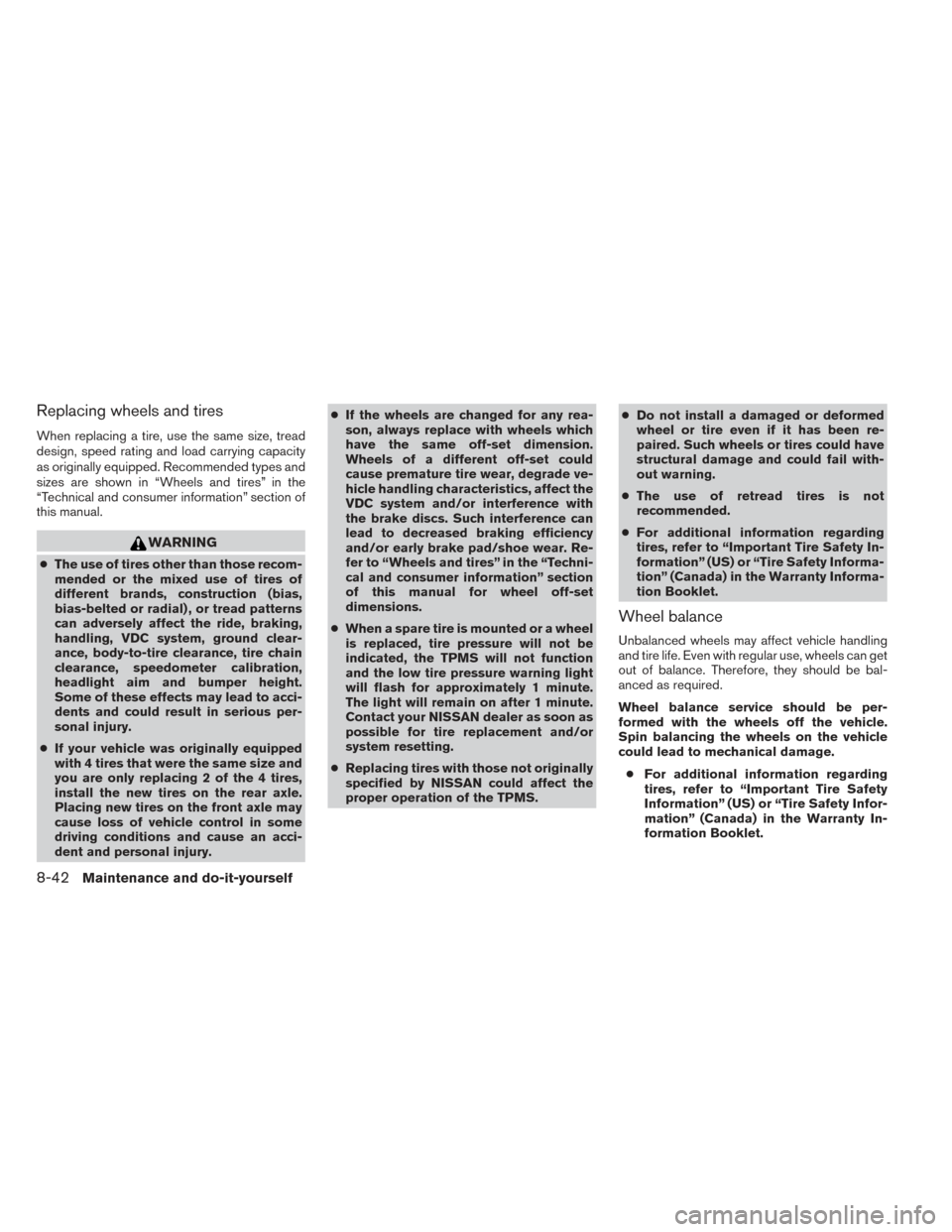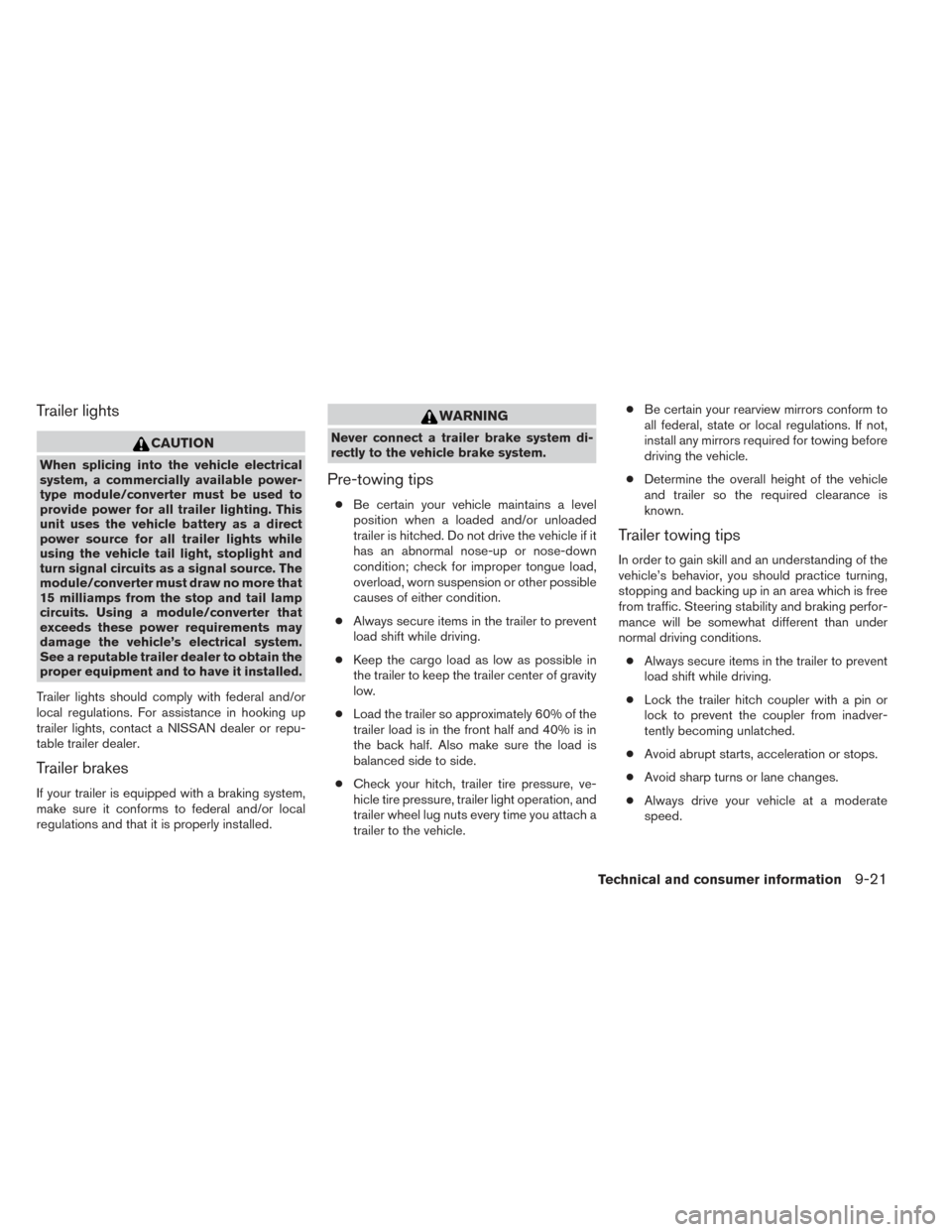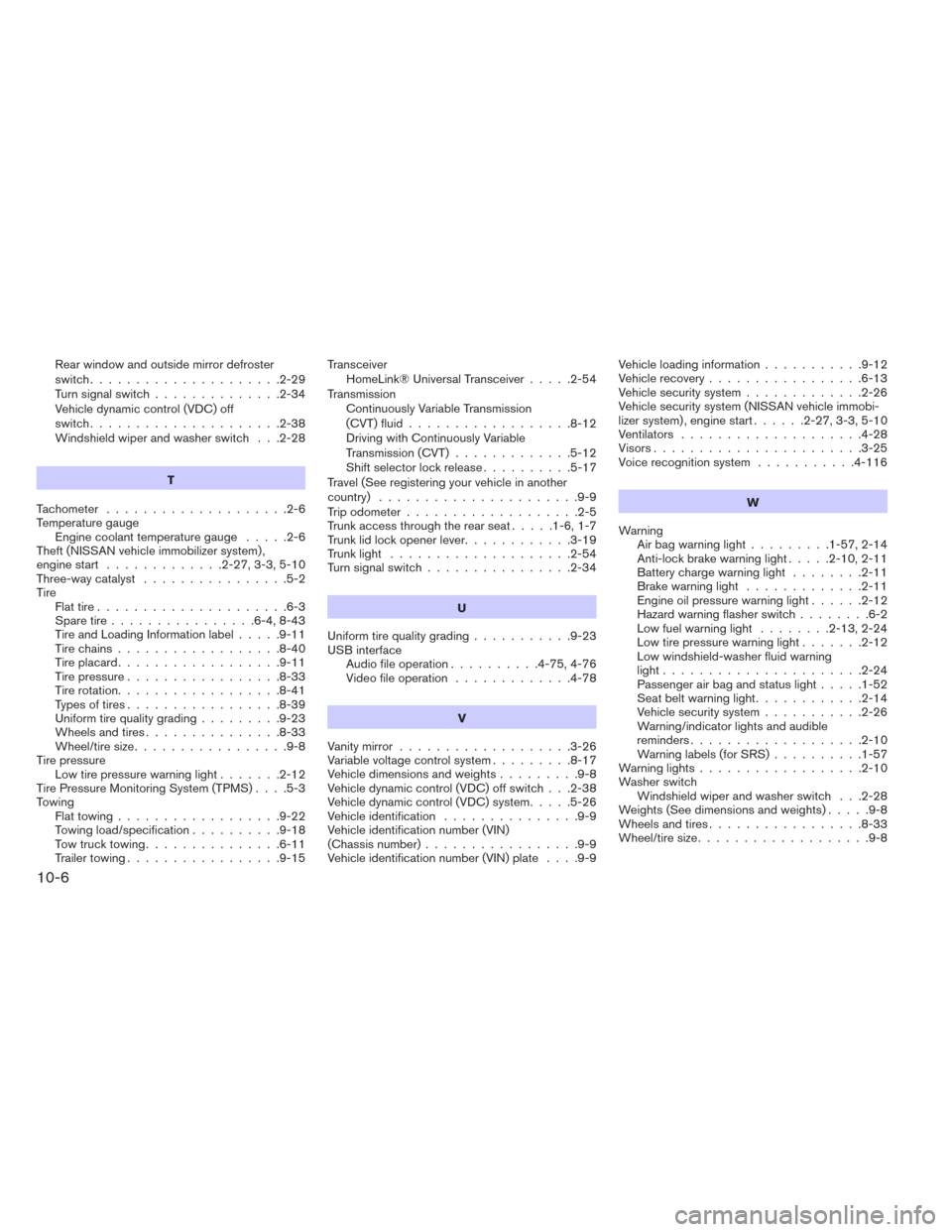2014 NISSAN MAXIMA tire type
[x] Cancel search: tire typePage 391 of 432

For additional traction on icy roads, studded tires
may be used. However, some U.S. states and
Canadian provinces prohibit their use. Check
local, state and provincial laws before installing
studded tires. Skid and traction capabilities of
studded snow tires on wet or dry surfaces may be
poorer than that of non-studded snow tires.
TIRE CHAINS
CAUTION
Tire chains/cables should not be installed
on P245/40VR19 size tires. Installation of
the tire chains/cables on P245/40VR19
size tires will cause damage to the vehicle.
If you plan to use tire chains/cables, you
should install P245/45VR18 size tires on
your vehicle.
Use of tire chains may be prohibited according to
location. Check the local laws before installing
tire chains. When installing tire chains, make sure
they are the proper size for the tires on your
vehicle and are installed according to the chain
manufacturer’s suggestions. Use only SAE
class “S” chains. Class “S” chains are used on
vehicles with restricted tire to vehicle clearance.
Vehicles that can use Class “S” chains are de-
signed to meet the minimum clearances between
the tire and the closest vehicle suspension or
body component required to accommodate the use of a winter traction device (tire chains or
cables) . The minimum clearances are determined
using the factory equipped tires. Other types may
damage your vehicle. Use chain tensioners when
recommended by the tire chain manufacturer to
ensure a tight fit. Loose end links of the tire chain
must be secured or removed to prevent the pos-
sibility of whipping action damage to the fenders
or underbody. If possible, avoid fully loading your
vehicle when using tire chains. In addition, drive
at a reduced speed. Otherwise, your vehicle may
be damaged and/or vehicle handling and perfor-
mance may be adversely affected.
Tire chains must be installed only on the
front wheels and not on the rear wheels.
Never install tire chains on a TEMPORARY USE
ONLY spare tire.
Do not use tire chains on dry roads. Driving with
chains in such conditions can cause damage to
the various mechanisms of the vehicle due to
some overstress.
CHANGING WHEELS AND TIRES
Tire rotation
NISSAN recommends rotating the tires
every 7,500 miles (12,000 km).
See “Flat tire” in the “In case of emer-
gency” section of this manual for tire re-
placing procedures.
As soon as possible, tighten the
wheel nuts to the specified torque
with a torque wrench.
WDI0258
8-40Maintenance and do-it-yourself
Page 393 of 432

Replacing wheels and tires
When replacing a tire, use the same size, tread
design, speed rating and load carrying capacity
as originally equipped. Recommended types and
sizes are shown in “Wheels and tires” in the
“Technical and consumer information” section of
this manual.
WARNING
●The use of tires other than those recom-
mended or the mixed use of tires of
different brands, construction (bias,
bias-belted or radial) , or tread patterns
can adversely affect the ride, braking,
handling, VDC system, ground clear-
ance, body-to-tire clearance, tire chain
clearance, speedometer calibration,
headlight aim and bumper height.
Some of these effects may lead to acci-
dents and could result in serious per-
sonal injury.
● If your vehicle was originally equipped
with 4 tires that were the same size and
you are only replacing 2 of the 4 tires,
install the new tires on the rear axle.
Placing new tires on the front axle may
cause loss of vehicle control in some
driving conditions and cause an acci-
dent and personal injury. ●
If the wheels are changed for any rea-
son, always replace with wheels which
have the same off-set dimension.
Wheels of a different off-set could
cause premature tire wear, degrade ve-
hicle handling characteristics, affect the
VDC system and/or interference with
the brake discs. Such interference can
lead to decreased braking efficiency
and/or early brake pad/shoe wear. Re-
fer to “Wheels and tires” in the “Techni-
cal and consumer information” section
of this manual for wheel off-set
dimensions.
● When a spare tire is mounted or a wheel
is replaced, tire pressure will not be
indicated, the TPMS will not function
and the low tire pressure warning light
will flash for approximately 1 minute.
The light will remain on after 1 minute.
Contact your NISSAN dealer as soon as
possible for tire replacement and/or
system resetting.
● Replacing tires with those not originally
specified by NISSAN could affect the
proper operation of the TPMS. ●
Do not install a damaged or deformed
wheel or tire even if it has been re-
paired. Such wheels or tires could have
structural damage and could fail with-
out warning.
● The use of retread tires is not
recommended.
● For additional information regarding
tires, refer to “Important Tire Safety In-
formation” (US) or “Tire Safety Informa-
tion” (Canada) in the Warranty Informa-
tion Booklet.
Wheel balance
Unbalanced wheels may affect vehicle handling
and tire life. Even with regular use, wheels can get
out of balance. Therefore, they should be bal-
anced as required.
Wheel balance service should be per-
formed with the wheels off the vehicle.
Spin balancing the wheels on the vehicle
could lead to mechanical damage.
● For additional information regarding
tires, refer to “Important Tire Safety
Information” (US) or “Tire Safety Infor-
mation” (Canada) in the Warranty In-
formation Booklet.
8-42Maintenance and do-it-yourself
Page 416 of 432

Trailer lights
CAUTION
When splicing into the vehicle electrical
system, a commercially available power-
type module/converter must be used to
provide power for all trailer lighting. This
unit uses the vehicle battery as a direct
power source for all trailer lights while
using the vehicle tail light, stoplight and
turn signal circuits as a signal source. The
module/converter must draw no more that
15 milliamps from the stop and tail lamp
circuits. Using a module/converter that
exceeds these power requirements may
damage the vehicle’s electrical system.
See a reputable trailer dealer to obtain the
proper equipment and to have it installed.
Trailer lights should comply with federal and/or
local regulations. For assistance in hooking up
trailer lights, contact a NISSAN dealer or repu-
table trailer dealer.
Trailer brakes
If your trailer is equipped with a braking system,
make sure it conforms to federal and/or local
regulations and that it is properly installed.
WARNING
Never connect a trailer brake system di-
rectly to the vehicle brake system.
Pre-towing tips
● Be certain your vehicle maintains a level
position when a loaded and/or unloaded
trailer is hitched. Do not drive the vehicle if it
has an abnormal nose-up or nose-down
condition; check for improper tongue load,
overload, worn suspension or other possible
causes of either condition.
● Always secure items in the trailer to prevent
load shift while driving.
● Keep the cargo load as low as possible in
the trailer to keep the trailer center of gravity
low.
● Load the trailer so approximately 60% of the
trailer load is in the front half and 40% is in
the back half. Also make sure the load is
balanced side to side.
● Check your hitch, trailer tire pressure, ve-
hicle tire pressure, trailer light operation, and
trailer wheel lug nuts every time you attach a
trailer to the vehicle. ●
Be certain your rearview mirrors conform to
all federal, state or local regulations. If not,
install any mirrors required for towing before
driving the vehicle.
● Determine the overall height of the vehicle
and trailer so the required clearance is
known.
Trailer towing tips
In order to gain skill and an understanding of the
vehicle’s behavior, you should practice turning,
stopping and backing up in an area which is free
from traffic. Steering stability and braking perfor-
mance will be somewhat different than under
normal driving conditions.
● Always secure items in the trailer to prevent
load shift while driving.
● Lock the trailer hitch coupler with a pin or
lock to prevent the coupler from inadver-
tently becoming unlatched.
● Avoid abrupt starts, acceleration or stops.
● Avoid sharp turns or lane changes.
● Always drive your vehicle at a moderate
speed.
Technical and consumer information9-21
Page 429 of 432

Rear window and outside mirror defroster
switch.....................2-29
Turnsignalswitch..............2-34
Vehicle dynamic control (VDC) off
switch.....................2-38
Windshield wiper and washer switch . . .2-28T
Tachometer ....................2-6
Temperature gauge Engine coolant temperature gauge .....2-6
Theft (NISSAN vehicle immobilizer system) ,
engine start .............2-27,3-3,5-10
Three-way catalyst ................5-2
Tire Flat tire .....................6-3
Spare tire ................6-4,8-43
Tire and Loading Information label .....9-11
Tire chains ..................8-40
Tireplacard..................9-11
Tirepressure.................8-33
Tire rotation..................8-41
Types of tires .................8-39
Uniform tire quality grading .........9-23
Wheels and tires ...............8-33
Wheel/tire size .................9-8
Tire pressure Low tire pressure warning light .......2-12
Tire Pressure Monitoring System (TPMS) ....5-3
Towing Flattowing..................9-22
Towingload/specification..........9-18
Towtrucktowing...............6-11
Trailertowing.................9-15 Transceiver
HomeLink® Universal Transceiver .....2-54
Transmission Continuously Variable Transmission
(CVT) fluid ..................8-12
Driving with Continuously Variable
Transmission (CVT) .............5-12
Shiftselectorlockrelease..........5-17
Travel (See registering your vehicle in another
country) ......................9-9
Trip odometer ...................2-5
Trunk access through the rear seat .....1-6,1-7
Trunk lid lock opener lever ............3-19
Trunklight ....................2-54
Turn signal switch ................2-34
U
Uniform tire quality grading ...........9-23
USB interface Audio file operation ..........4-75,4-76
Video file operation .............4-78
V
Vanity mirror ...................3-26
Variable voltage control system .........8-17
Vehicle dimensions and weights .........9-8
Vehicle dynamic control (VDC) off switch . . .2-38
Vehicle dynamic control (VDC) system .....5-26
Vehicle identification ...............9-9
Vehicle identification number (VIN)
(Chassis number) .................9-9
Vehicle identification number (VIN) plate ....9-9Vehicleloadinginformation...........9-12
Vehicle recovery
.................6-13
Vehicle security system .............2-26
Vehicle security system (NISSAN vehicle immobi-
lizer system) , engine start ......2-27,3-3,5-10
Ventilators ....................4-28
Visors.......................3-25
Voice recognition system ...........4-116
W
Warning Airbagwarninglight.........1-57, 2-14
Anti-lock brake warning light .....2-10,2-11
Battery charge warning light ........2-11
Brake warning light .............2-11
Engine oil pressure warning light ......
2-12
Hazard warning flasher switch ........6-2
Low fuel warning light ........2-13, 2-24
Low tire pressure warning light .......2-12
Low windshield-washer fluid warning
light......................2-24
Passenger air bag and status light .....1-52
Seatbeltwarninglight............2-14
Vehicle security system ...........2-26
Warning/indicator lights and audible
reminders...................2-10
Warning labels (for SRS) ..........1-57
Warninglights..................2-10
Washer switch Windshield wiper and washer switch . . .2-28
Weights (See dimensions and weights) .....9-8
Wheels and tires .................8-33
Wheel/tire size ...................9-8
10-6